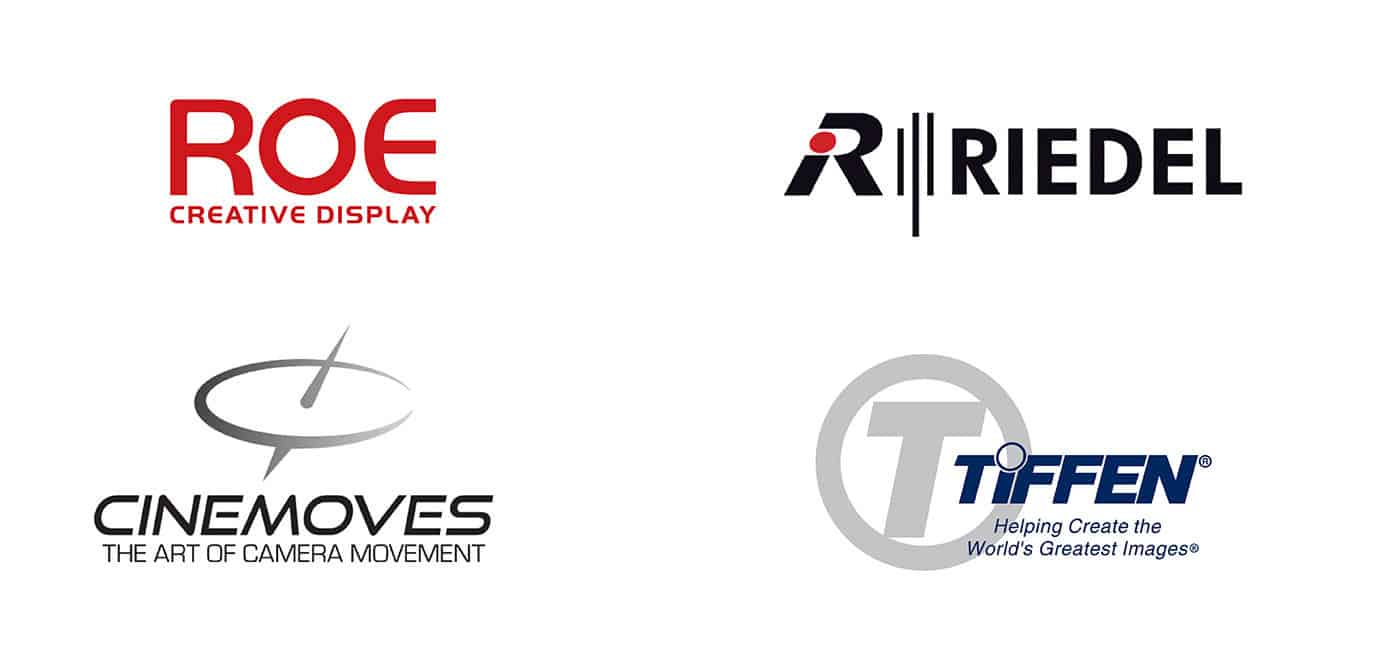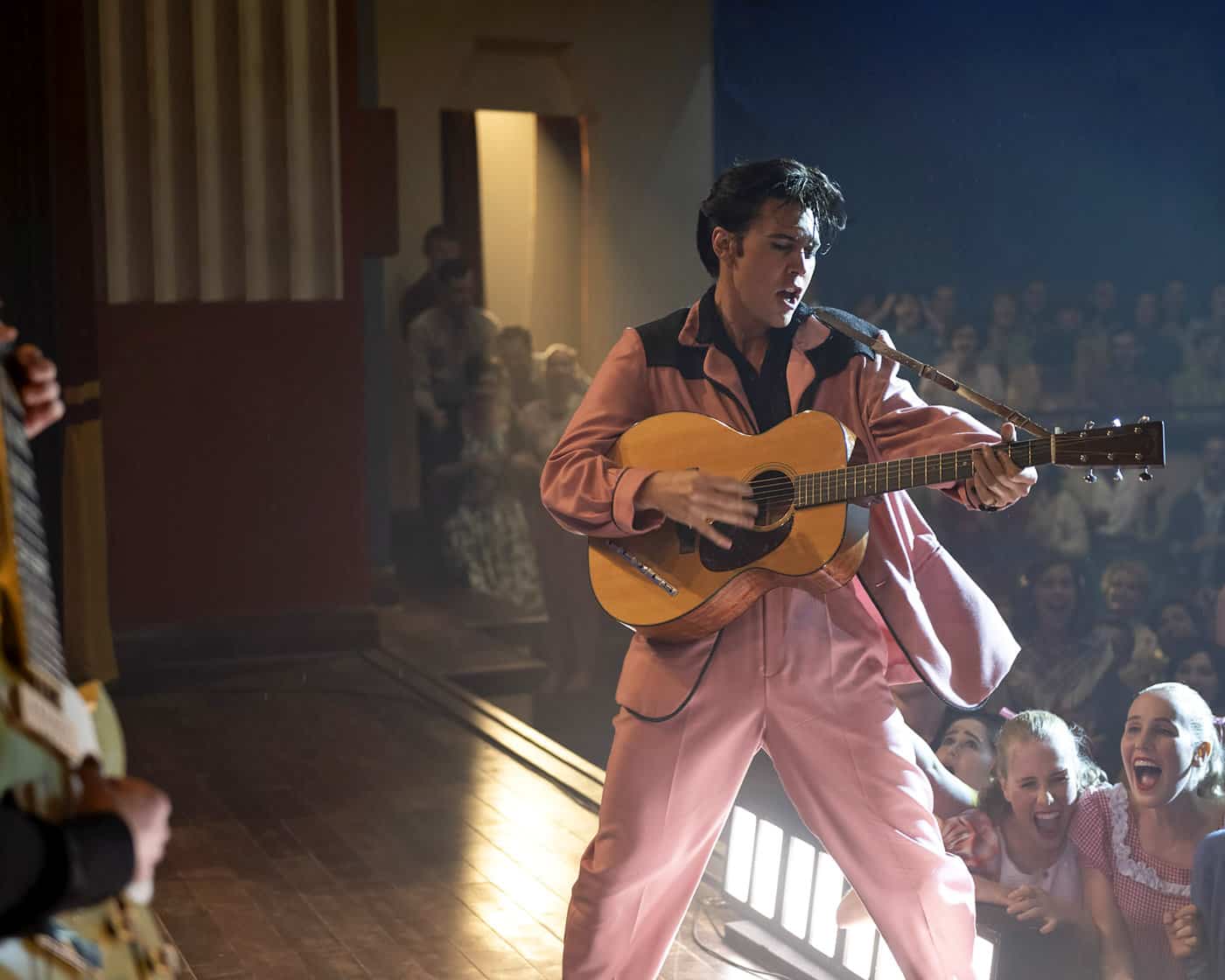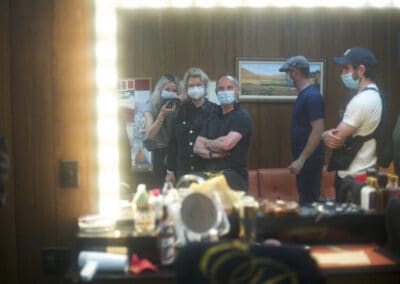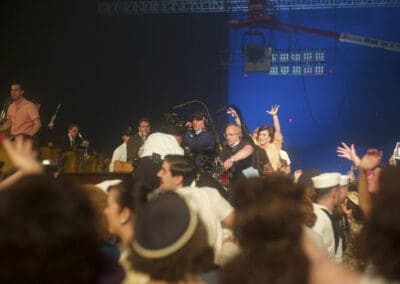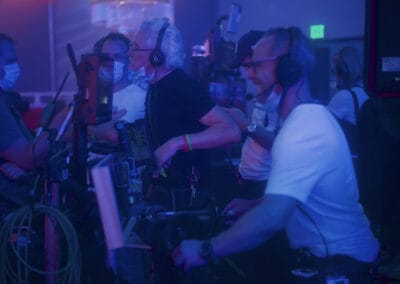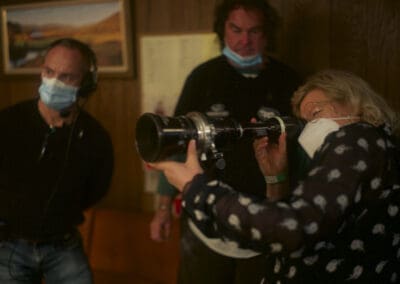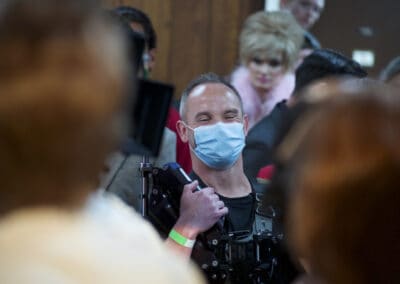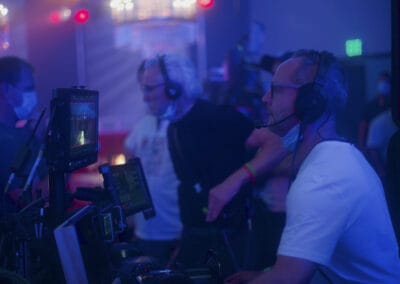Elvis
Taking Care of Business
By Jason Ellson, SOC
Taking a page from his earlier films Moulin Rouge! and The Great Gatsby, Baz Luhrman’s Elvis is a maximalist mythologizing of the life of “The King of Rock and Roll” told from the deathbed of the man who both made his career and ruined his life.
The film stars Austin Butler, almost spookily channeling the essence of the film’s larger-than-life central figure, alongside Tom Hanks playing Presley’s business manager, Colonel Tom Parker, like a villain straight out of the Captain Marvel Jr. comics that Elvis read as a child.
Writing for Camera Operator magazine, A camera operator Jason Ellson talks about his experience working on the film he describes as “a hyperkinetic whirl of sound and vision.” Keeping up with this maelstrom of moviemaking meant being prepared with the right tools to provide Luhrman the ultimate flexibility to pursue his vision—whether that was shooting inside the confines of a tiny wardrobe or recreating the lavish, extravagant musical spectacles of Elvis’ Las Vegas residency.
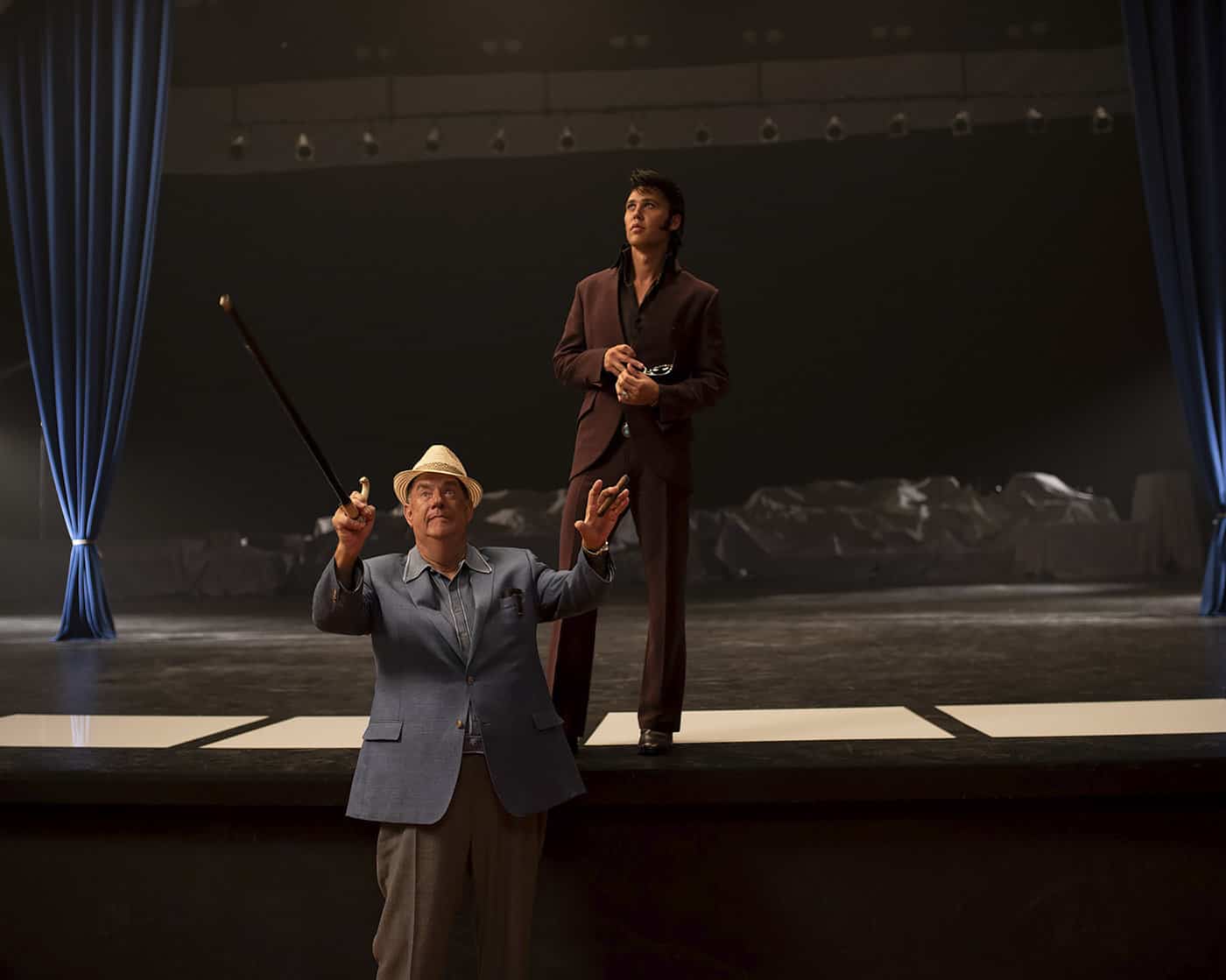
Austin Butler as Elvis and Tom Hanks as Colonel Tom Parker
When director of photography Mandy Walker called me to let me know she was doing Elvis with Baz Luhrman, I was absolutely thrilled. I knew they have a long history together and that their collaboration on a film about Elvis Presley would be nothing shy of visually amazing! The film follows the life of rock and roll icon, singer, and actor Elvis Presley, told from the perspective of his manager, Colonel Tom Parker. It stars Austin Butler in the title role with Tom Hanks as Colonel Tom Parker. The film was shot entirely on the Gold Coast so for me it was really nice to be back in Australia.
I have done six films with Mandy, and I feel really honored and grateful for the freedom she affords me as an operator to workshop ideas and create with her and the director. If you have seen a Baz Luhrman film, then you know they are a sensory feast! This film is no exception. It plays like a hyperkinetic whirl of sound and vision that rarely slows to catch its breath—and neither did we! Baz loves to move the camera; it’s like being in an orchestra where he is the conductor, often conducting camera and actors during the take.
Mandy decided to use the ALEXA 65 for this film as she wanted to utilize the sprawling canvas this format offers, seeking a scope of particularly monumental proportions, much like Elvis’ life. For the pre-Vegas section of Elvis we used Spheros and then went anamorphic for the latter half of the film with the T Series.
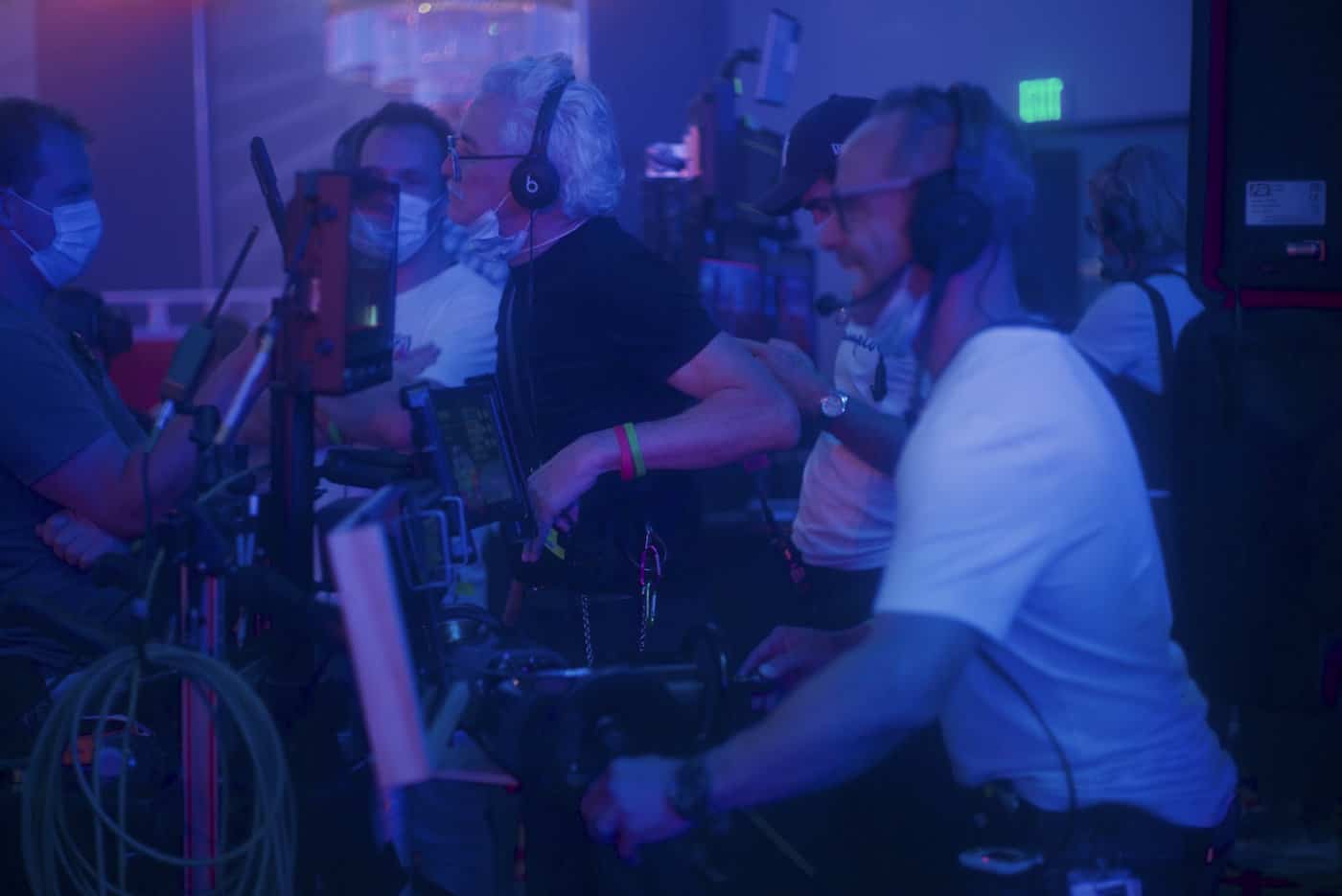
Jason Ellson on the set of ELVIS
We were fortunate to have—by necessity—an extensive toolbox at our disposal. I learned very early on working with Baz that things can change very quickly from where they started, and you need to be prepared. Depending on which set we were on, I would offer up the most efficient tool to give him the scope to move around the set as unrestricted as possible. For example, in the musical performances, we would almost always start on the crane. The performances were often bookended with drama in which we would generally get in there with Steadicam or handheld to cover those moments. There is a scene in a very tiny wardrobe where we used a very small jib arm with the Mo-Sys head on track. This gave us the flexibility to put the camera into every nook and cranny within the constricted space.
Beale Street was mostly Steadicam as Baz wanted the freedom for Austin to walk down the streets interacting with extras along the way. Mandy was completely on board with this too; she had lit most sets for 360 degrees and would basically just adjust the back light accordingly. I don’t think there was anything that was out of bounds! We deployed the 45-foot Scorpio crane a lot with a MATRIX head managed by head tech extraordinaire Mike Larcombe. We really pushed the MATRIX head to the limits of what it was capable of and it blew me away what we were able to achieve with it. It performed flawlessly. There are a lot of camera rotations in this film and the big advantage of the CineMoves MATRIX head is that it does not matter what angle the head is at, you can add a rotation any time.
Having the Scorpio 45-foot crane and the ability to program the arm with the arc compensator when you are off axis was a real asset, especially in some of the smaller sets where we needed very linear moves at odd crane arm angles. It’s funny, you could be on the most massive sound stage ever but, for some reason, you always seem to be squished against a wall with a crane in the far corner trying to thread the needle with the camera! In addition to the 45, we had a 23-foot Scorpio with an Oculus head and two jibs on dollies that we used with the Mo-Sys L40, plus the regular grip support.
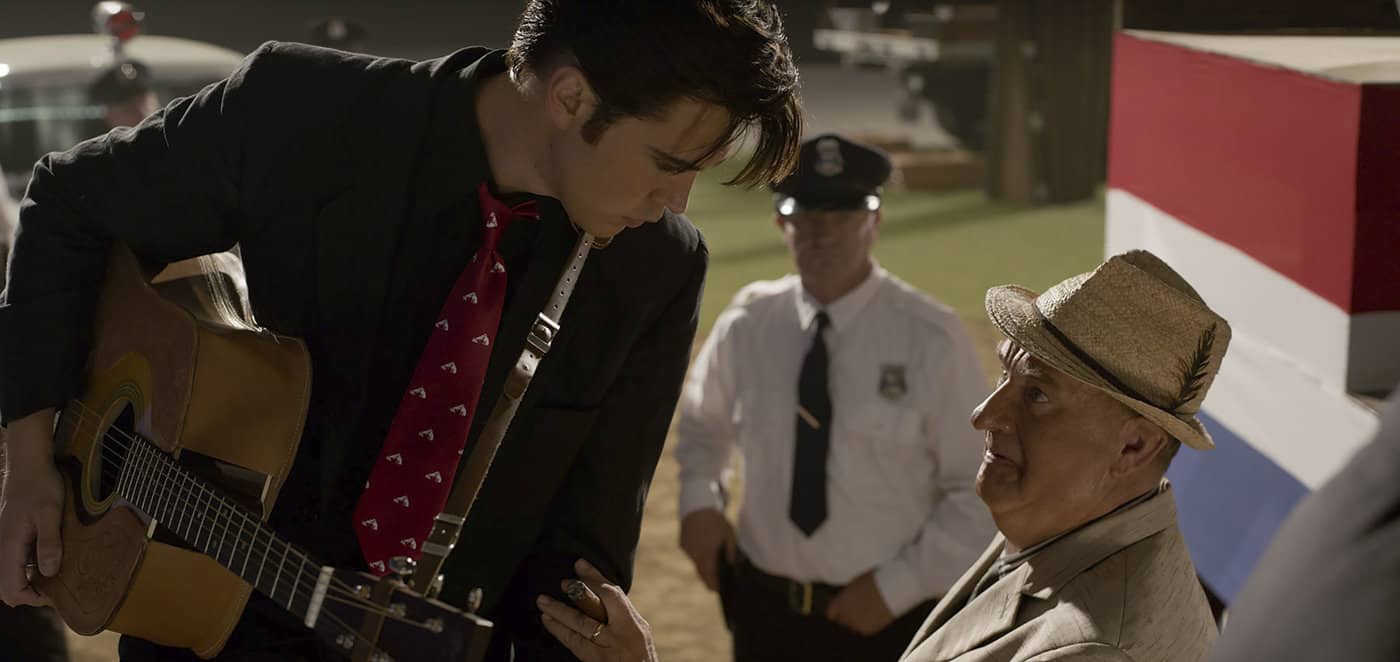
Austin Butler as Elvis and Tom Hanks as Colonel Tom Parker
I really need to give a massive shout out to my core team who I had worked with pre-COVID on Mortal Kombat: 1st AC Luke Thomas and 2nd AC Jeremy “Jez” Wheatley. There were a lot of camera conversions each day on this film—a lot! We had two other ALEXA 65 bodies, but they were often being used simultaneously on almost every setup by the B and C teams, so the idea of having a camera pre-built for Steadicam or another mode was not an option. Sometimes we would start on the crane, jump to Steadicam, back to crane, then hand held, “Oh, let’s now do a shot on the jib with the Mo-Sys!”—and this was all before morning tea! Luke and Jez were amazing in the fog of war. There is such a massive and passionate talent pool in Australia; I felt really proud, honored, and supported working there. In addition to managing all the equipment, Luke did a really incredible job pulling focus on this film, consistently nailing shots that were near impossible with no rehearsals and things changing on the fly.
I cannot highlight enough the importance of how the operators’ execution of a shot is married to the dolly grip. Both those crafts need to be in harmony together; a good dolly grip needs to be empowered to create and improvise. In my mind, the greatest asset you can have as a camera operator is an amazing dolly grip. I was very fortunate to team up again with A camera dolly grip Brett “Bretto” McDowell, who embodies all this. I cannot speak highly enough of Bretto, as a technician and as a human. It would not matter how complicated the shot was, he would consistently put the camera where it needed to be with storytelling grace and finesse, every time. Plus, I think Bretto was the dolly grip on every film that Baz has made, so there’s a massive mutual respect between them. Ian “Geeza” Barton was the Scorpio pickle operator. He had an extremely tough and, at times, nerve wracking job flying the camera full speed only inches from the actors, which he did with great precision.
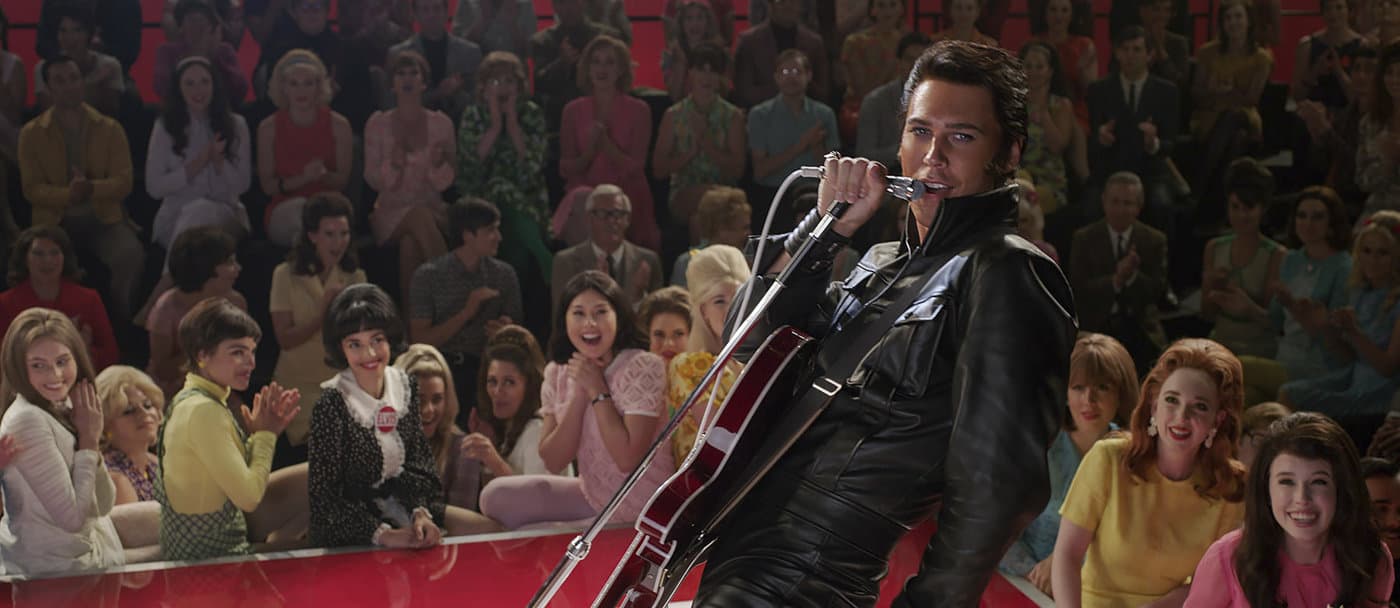
In my mind there were two key components to this film: there was the drama and then there was the performances. There were a few specific performances which Baz wanted to reproduce exactly—matching exactly how it was shot back then, with Austin performing as Elvis, replicating the same camera angles, movement, and even costume-matching the extras in the crowd from those original televised performances! Baz called those “trainspotting” sequences. One of them was the 1968 NBC Special, and the other was a documentary of Elvis when he first went to Vegas called That’s the Way It Is. We spent a lot of time studying the archival footage, mapping out camera positions, focal lengths, zoom cues, and camera movement in sync with performance. We needed to be efficient and well rehearsed so as not to unnecessarily burn Austin out. Austin just put everything into being Elvis; in my mind he was Elvis.
We used zooms a lot on the Technocrane for many of these performances. There was a little bit of a learning curve holding the fiz in my palm, using my thumb for the zoom and my fingers of the same hand on the wheels. CineMoves kindly sent out their Mimic overnight for me to try so I could operate as though I was on a fluid head, however it just didn’t feel right. It’s funny, I think I walked around the bazooka on which the Mimic/O’Connor was mounted three times in one performance! I ended up going back to the wheels/fiz combo.
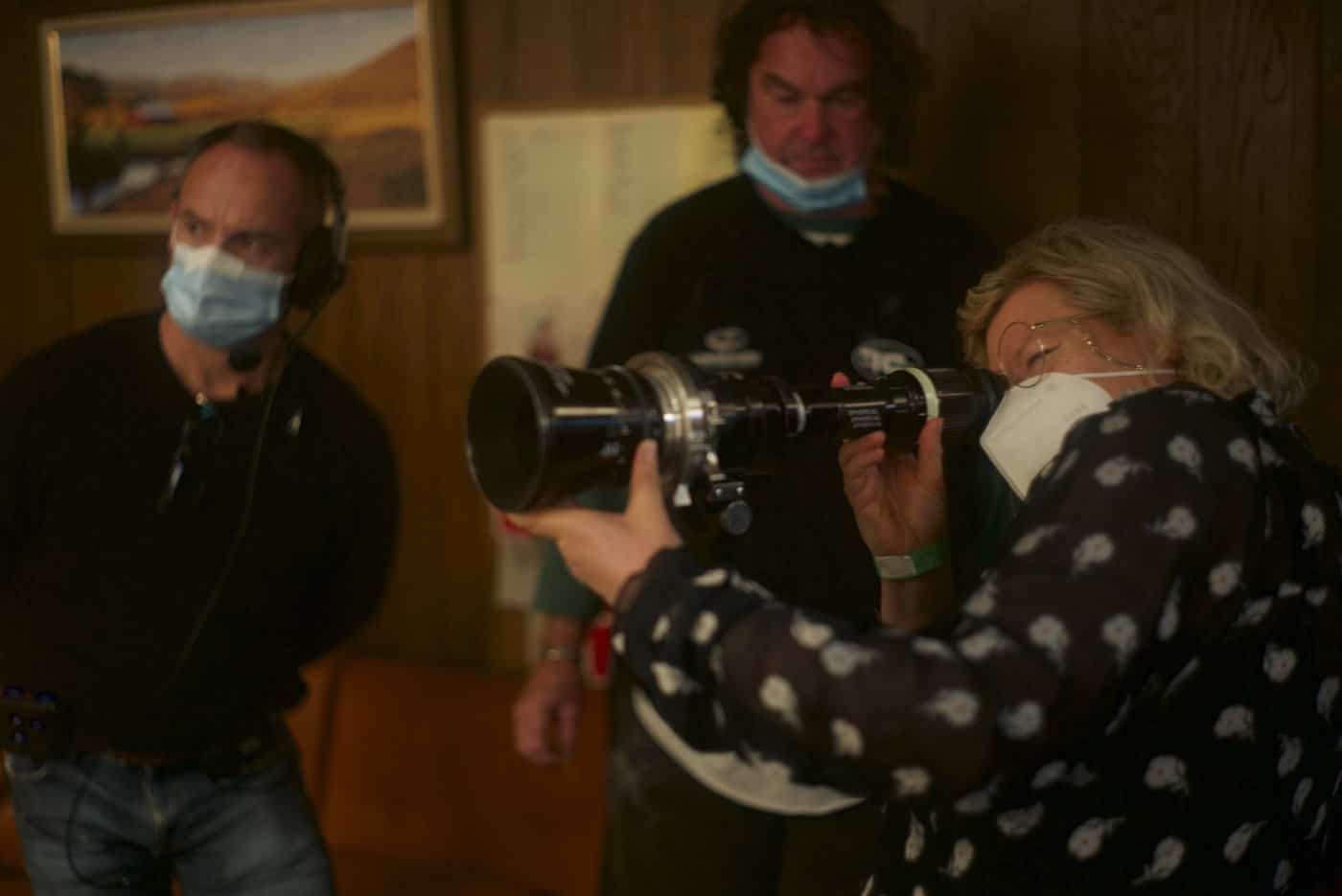
Jason Ellson on the set of ELVIS
Baz is one of those directors who has this charismatic ability to make everyone on set feel really important, which I think creates an amazing environment for creativity and positive energy. We would often go into his office on wrap to discuss how the day went, what worked, what didn’t and how we can be more efficient as a team moving forward. It was a real honor to be in his wheelhouse and a part of his process. Mandy, 1st AD Jack Ravenscroft, and myself would start most days an hour or two before crew call where we would meet with Baz to discuss the day’s work. Often this would be an impromptu theatre play where we would play a character in the scene with Baz directing us. The short straw was always Vernon Presley, because you always felt sorry for poor Vernon. We would then bring the actors in to rehearse, loosely blocking off our very poor but enthusiastic acting skills. Baz would then work with the actors and they would shape the scene. It was quite amazing.
Baz would block most scenes, which more often than not began with an intricate master. They would be nerve wracking, exhilarating, and extremely satisfying all at the same time! We would spend a lot time perfecting all the moving parts of the master and then move into coverage. I would always try to position my wheels station as close as possible to Baz so he could give notes on the fly or after a take so there was an immediate, clear, direct line of communication. Mandy was the same, she would light on the set, maybe poke her head into DIT for a rehearsal take but would do most of her work off a calibrated monitor next to us. Her gaffer, Shaun Conway, would be monitoring in DIT during the takes. This created a really efficient and immediate line of communication between us all.
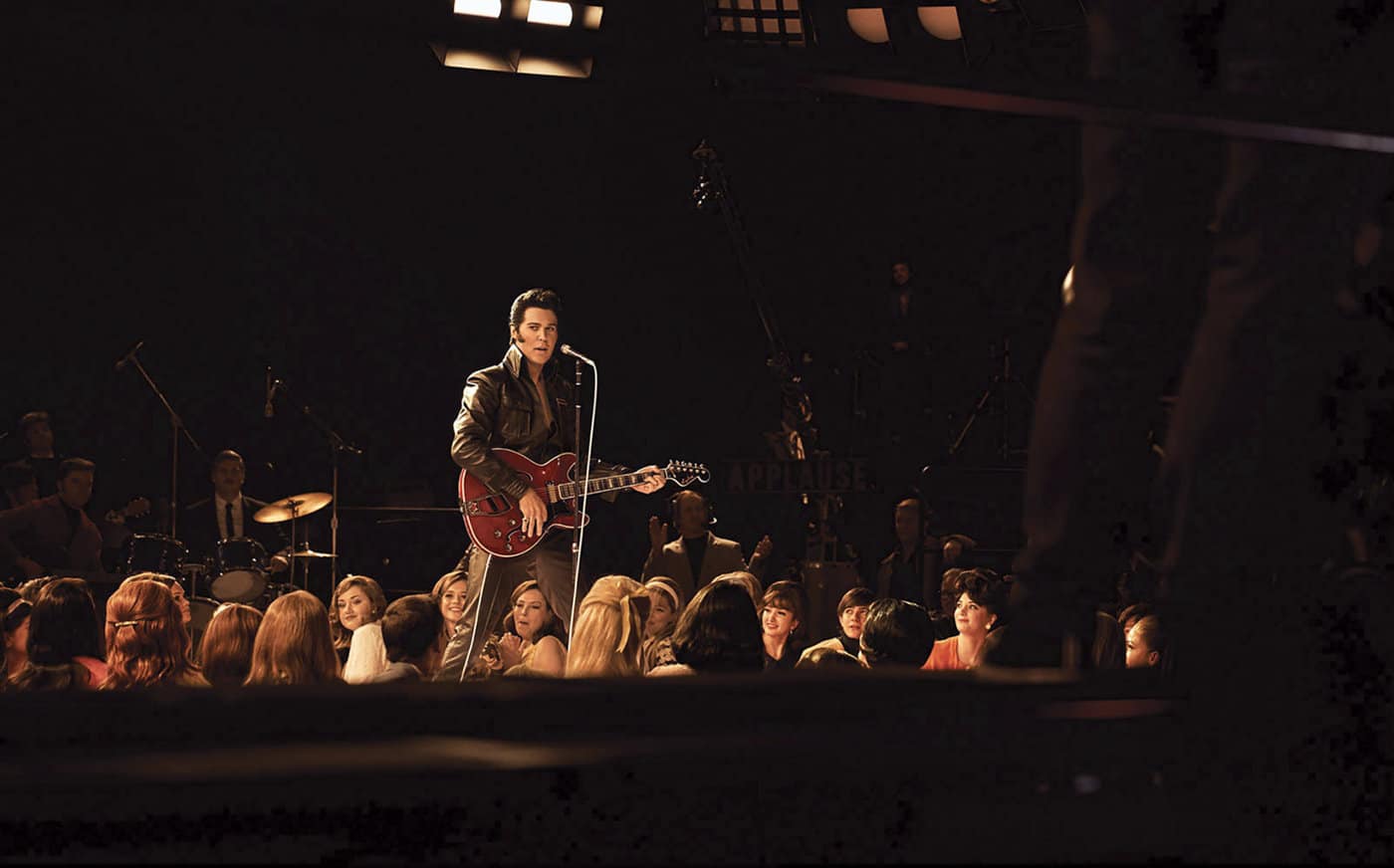
I would be remiss not to mention our B camera team—operator Jay Torta, 1st AC Ron Coe, 2nd AC Anysha Rankin—and our C camera team—operator Scott Dolan, 1st AC Robbie Mackinnon, and 2nd AC Kristi Gilligan—who all did an amazing job!
Elvis was definitely a career highlight for me. It was an amazing opportunity to work on a Baz Luhrman film, one I will never forget. Working with Mandy is always such a pleasure. We have a shorthand that I think works really well, and it’s a real treat to go to work with one of your best mates who you have the utmost respect for.
Elvis was shot during the height of the pandemic. Most of the crew had been in long lockdowns. All were required to do an additional two-week forced hotel quarantine for domestic and international travel on arrival in Queensland just to be a part of this project. The tyranny of distance with a film family has always been hard; we live like vagabonds, similar to the antagonist in this film, searching for the next best project. However the pandemic took our world to a wholly new, unknown level. There wasn’t the option to fly your family out, and there wasn’t the option to go home without an extensive quarantine period. Crew members were getting their brains and noses scraped every day, wearing masks and face shields in sweltering temperatures just to follow a passion, a dream. I take my hat off to all my brothers and sisters who endured strict production protocols during this time, on Elvis and all other productions that were being filmed around the world. Respect.
Camera Operator Fall 2022
Above Photo: Austin Butler as Elvis
Photo courtesy of Warner Bros. Behind-the-scenes photos by Ruby Bell
TECH ON SET
ALEXA 65
Panavision Sphero & T-series Anamorphic Lenses
45’ & 23’ Scorpio Crane
Matrix Head
Oculus Head
Mo-Sys L40
Steadicam
RELATED CONTENT
Jason Ellson
Learn more about Jason’s career and projects at IMDB.com
Hidden Figures: Unveiling the Remarkable in the Winter 2017 Camera Operator
BEHIND THE SCENES
Select Photo for Slideshow
Jason Ellson, SOC
Jason Ellson, SOC, is a camera and Steadicam operator based in Los Angeles. Jason began his career shooting news and documentaries in Australia and South East Asia. He became an accredited Steadicam operator in 1998 before moving to the United States in 2000, where he followed his passion to pursue a career in narrative work. When Jason is not working, he loves spending time with his wife and three children. A key component of his lifestyle is geared towards fitness. Jason’s credits include Hidden Figures, Mulan, Mortal Kombat, Ghostbusters: Afterlife and the upcoming Black Panther: Wakanda Forever. He was nominated for Camera Operator of the Year in 2021 for his work on Mulan.
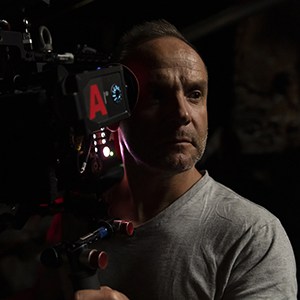
SPECIAL THANKS TO OUR ADVERTISERS
